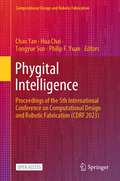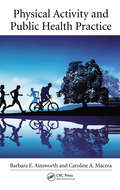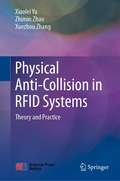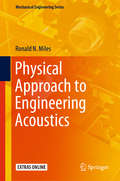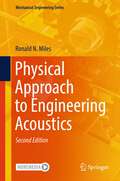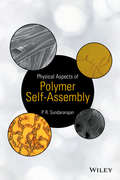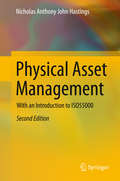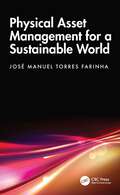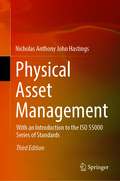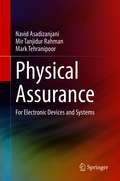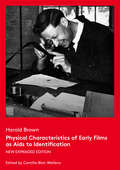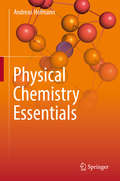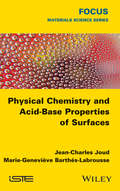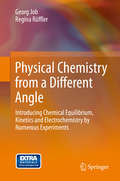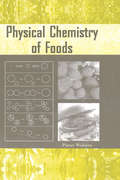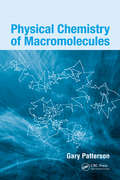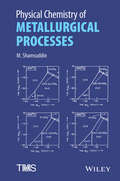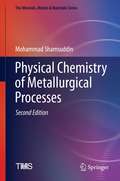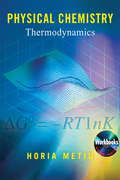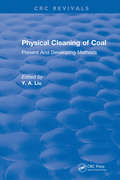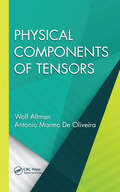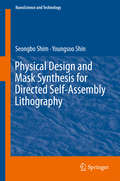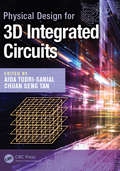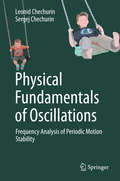- Table View
- List View
Phycotoxins: Chemistry and Biochemistry
by Luis M. Botana Amparo AlfonsoPhycotoxins are a diverse group of poisonous substances produced by certain seaweed and algae in marine and fresh waters and are important to the scientific community for many reasons, the most obvious being that they pose food safety issues which requires a large investment to regularly monitor the presence of these compounds in foods. Phycotoxins: Chemistry and Biochemistry, second edition presents the most updated information available on phycotoxins. Major emphases are given to chemistry and biochemistry, while origins, mechanism of action, toxicology, and analytical methodology are also covered. Since the publication of the first edition, there have been major advances in the science of marine and aquatic toxins, as well as advances in toxicology, analytical chemistry and pharmacology. This fully revised and updated edition includes several new chapters, including those on ciguatoxins, pinnatoxin, ichthyotoxins, as well as new chapters on food safety control of marine toxins, climate change and water toxins, and microalgae as a source of nutraceuticals. The book will be of interest to toxicologists, marine, food, and plant scientists, as well as researchers and academics in the areas of food science, medicine, public health, toxicology, pharmacology and marine biology.
Phygital Intelligence: Proceedings of the 5th International Conference on Computational Design and Robotic Fabrication (CDRF 2023) (Computational Design and Robotic Fabrication)
by Philip F. Yuan Chao Yan Hua Chai Tongyue SunThis open access book is a compilation of selected papers from 2023 DigitalFUTURES — The 5nd International Conference on Computational Design and Robotic Fabrication (CDRF 2023). The work focuses on novel techniques for computational design and robotic fabrication. The contents make valuable contributions to academic researchers, designers, and engineers in the industry. As well, readers will encounter new ideas about understanding intelligence in architecture.
Physical Activity and Public Health Practice
by Barbara E. Ainsworth Caroline A. MaceraPhysical activity remains a critical area of research as we consider cost-effective measures for lowering the chronic disease epidemic worldwide. In our increasingly automated society, many adults and children are not active at health-enhancing levels. In Physical Activity and Public Health Practice, a panel of respected researchers summarizes esse
Physical Anti-Collision in RFID Systems: Theory and Practice
by Xiaolei Yu Zhimin Zhao Xuezhou ZhangThis book highlights the innovative applications of electromagnetics, optics, thermodynamics theories in creating methods for physical-layer collision prevention- "physical anti-collision" in radio frequency identification (RFID) systems. Using engineering mathematical methods as the core of detection and control algorithm design, it proposes semi-physical verification and detection techniques to the dynamic performance testing in RFID systems. The book also introduces the methods to build semi-physical hardware platforms using photoelectric sensing technology. The book provides valuable ideas to the applications of Internet of Things (IOT) systems in smart logistics, car networking, food traceability, anti-counterfeiting and other livelihood fields. It is worth reading for all researchers in IOT and optoelectronic engineering related industries.
Physical Approach to Engineering Acoustics (Mechanical Engineering Series)
by Ronald N. MilesThis textbook presents the fundamentals of engineering acoustics and examines in depth concepts within the domain that apply to reducing noise, measuring noise, and designing microphones and loudspeakers. The book particularly emphasizes the physical principles used in designing miniature microphones. These devices are used in billions of electronic products, most visibly, cell phones and hearing aids, and enable countless other applications. Distinct from earlier books on this topic that take the view of the electrical engineer analyzing mechanical systems using electric circuit analogies. This text uses Newtonian mechanics as a more appropriate paradigm for analyzing these mechanical systems and in so doing provides a more direct method of modeling. Written at a level appropriate for upper-division undergraduate courses, and enhanced with end-of-chapter problems and MatLab routines, the book is ideal as a core text for students interested in engineering acoustics in ME, EE, and physics programs, as well as a reference for engineers and technicians working in the huge global industry of miniature microphone design.
Physical Approach to Engineering Acoustics (Mechanical Engineering Series)
by Ronald N. MilesThis updated edition adds new material on the acoustics of mufflers and ducts, including a new analysis on sound propagation in a duct having a cross sectional area that varies in the direction of the duct length. The textbook retains its class-tested fundamentals of engineering acoustics and examination of in-depth concepts within the domains that apply to reducing noise, measuring noise, and designing microphones and loudspeakers. The book particularly emphasizes the physical principles used in designing miniature microphones. These devices are used in billions of electronic products, most visibly, cell phones and hearing aids, and enable countless other applications. Distinct from earlier books on this topic that take the view of the electrical engineer analyzing mechanical systems using electric circuit analogies. This text uses Newtonian mechanics as a more appropriate paradigm for analyzing these mechanical systems and in so doing provides a more direct method of modeling. Written at a level appropriate for upper-division undergraduate and graduate courses, and enhanced with end-of-chapter problems and MatLab routines, the book is ideal as a core text for students interested in engineering acoustics in ME, EE, and physics programs, as well as a reference for engineers and technicians working in the huge global industry of miniature microphone design.
Physical Aspects of Polymer Self-Assembly
by P. R. SundararajanOffering an overview of principles and techniques, this book covers all major categories of self-assembled polymers - properties, processes, and design. Each chapter focuses on morphology, applications, and advanced concepts to illustrate the advantages of polymer self-assembly across industrial and academic research. * Provides an organized, comprehensive overview of polymer self-assembly, its fundamentals, principles, and applications* Includes chapters on block copolymers, amphiphilic polymers, supramolecular polymers, rotaxenes, polymer gels, dendrimers, and small molecules in polymer matrices* Focuses on novel applications, block copolymer assembly to nanotechnology, photonics and metamaterials, molecular machines and artificial muscle, gels that can be applied to polymer science, materials science, and nanotechnology* Examines state-of-the-art concepts, like lithographic patterning and foldaxane* Discusses challenges and future outlook of a popular and emerging field of study
Physical Asset Management
by Nicholas Anthony John HastingsSignificantly extended from the first edition and published in response to the new international standard ISO55000, this book on physical asset management (2nd Ed. ) presents a systematic approach to the management of physical assets from concept to disposal. It introduces the general principles of physical asset management and covers all stages of the asset management process, including initial business appraisal, identification of fixed asset needs, capability gap analysis, financial evaluation, logistic support analysis, life cycle costing, management of in-service assets, maintenance strategy, outsourcing, cost-benefit analysis, disposal and renewal. Physical asset management is the management of fixed assets such as equipment, plant, buildings and infrastructure. Features include: *Suitable for university courses and builds on first edition to provide further analytical material *Aligned with the international asset management standard ISO55000 *Provides a basis for the establishment of physical asset management as a professional discipline *Presents case studies, analytical techniques and numerical examples with solutions Written for practitioners and students in asset management, this textbook provides an essential foundation to the topic. It is suitable for an advanced undergraduate or postgraduate course in asset management, and also offers an ideal reference text for engineers and managers specializing in asset management, reliability, maintenance, logistics or systems engineering.
Physical Asset Management for a Sustainable World
by José Manuel FarinhaThis book describes techniques, tools, and models about engineering maintenance and life cycle models, aimed at the efficient managing of assets. It presents new asset management models, namely the Holistic Diagnostic Model (HDM) and Integrated Asset Management Support Model (IAMSM), including quantitative decision support tools for life cycle management of physical assets. It presents an overview of the life cycle models for replacement through a global model, with emphasis on availability and maintenance costs. Features: Covers important aspects on Physical Asset Management (PAM) and offers a developed perspective on the economic aspects. Presents the relationships among some maintenance Key Performance Indicators (KPI), specifically MTTR, MTBF, Availability, and Reserve equipment. Analyzes models to calculate the influence of relevant variables on the withdrawal time and in the reserve size of the critical assets. Introduces new diagnostic models and Life Cycle decision support models. Includes new models for diagnosing organizations including pertinent case studies. This book is aimed at researchers, professionals, and graduate students in PAM, maintenance management, and industrial engineering.
Physical Asset Management: With an Introduction to the ISO 55000 Series of Standards
by Nicholas Anthony HastingsThis book presents a systematic approach to the management of physical assets from concept to disposal, building upon the previous editions and brought up-to-date with the new international standards ISO55002 and ISO/TS50010. It introduces the general principles of physical asset management and covers all stages of the asset management process, including initial business appraisal, identification of physical asset needs, capability gap analysis, financial evaluation, logistic support analysis, life cycle costing, strategic asset management planning, maintenance strategy, outsourcing, cost-benefit analysis, disposal and renewal. Features include:providing a textbook for asset management courses to university level;relating closely to the ISO55000 international asset management standard series;providing a basis for the establishment of physical asset management as a professional discipline; andpresenting case studies, analytical techniques and numerical examples with solutions. Written for practitioners and students in asset management, this book provides an essential foundation to the topic. It is suitable for an advanced undergraduate or postgraduate course in asset management and also offers an ideal reference text for engineers and managers specializing in asset management, reliability, maintenance, logistics or systems engineering.
Physical Assurance: For Electronic Devices and Systems
by Mark Tehranipoor Navid Asadizanjani Mir Tanjidur RahmanThis book provides readers with a comprehensive introduction to physical inspection-based approaches for electronics security. The authors explain the principles of physical inspection techniques including invasive, non-invasive and semi-invasive approaches and how they can be used for hardware assurance, from IC to PCB level. Coverage includes a wide variety of topics, from failure analysis and imaging, to testing, machine learning and automation, reverse engineering and attacks, and countermeasures.
Physical Characteristics of Early Films as Aids to Identification: New expanded Edition
by Camille Bolt-WellensAny archivists who have held a piece of fi lm in their hands, wondering how to go about identifying it, recognize the true value of fi lm preservationist Harold Brown's work. In 1967 Brown delivered a pioneering lecture on the identification of early films at the annual Congress of the International Federation of Film Archives (FIAF) in East Berlin. Years of working with Britain's National Film Archive collections, and the close examination of thousands of nitrate prints of the silent period, made Brown a leading authority on early fi lm identification, and an unsurpassed model of methodological consciousness in the archival field. In 1990, FIAF published Brown's Physical Characteristics of Early Films as Aids to Identification, an updated version and a continuation of his 1967 lecture. This publication has long been archivists' trusted companion, constituting a concentrated encyclopedia on all the information that can be discovered or verified through aspects of the fi lm other than the actual projected image – such as perforation shapes; embossed and punched marks; stock manufacturers' and producers' edge marks; frame characteristics; title styles; and production serial numbers. It also included essays on key individual production companies of the silent era. Over the last 30 years, this manual – a basic typewritten 100-page volume (including 20 pages of black & white illustrations), with its easily recognizable red cover – has been an invaluable reference for fi lm archivists and scholars. However, as Brown himself acknowledged in the 1990 edition, the manual was far from definitive. Camille Blot-Wellens, the editor of this new, expanded edition of Brown's 1990 book, belongs to the new generation of researchers who have used Physical Characteristics extensively in their work and have gathered considerable new information on the subject. This new edition is the result of a project she initiated in 2014 with FIAF's support. Brown's original text is now augmented with new original research on key fi lm manufacturers and producers by Camille Bolt-Wellens and other leading archivists and researchers in the field. Richly illustrated (the book contains over 900 images, including 125 in full color), this new 336-page edition of Harold Brown's seminal manual will be welcomed by many, and will no doubt become a must-have working tool for many in the fi lm archiving and academic fields.
Physical Chemistry Essentials
by Andreas HofmannThis textbook covers the fundamentals of physical chemistry, explaining the concepts in an accessible way and guiding the readers in a step-by-step manner. The contents are broadly divided into two sections: the classical physico-chemical topics (thermodynamics, kinetics, electrochemistry, transport, and catalysis), and the fabric of matter and its interactions with radiation. Particular care has been taken in the presentation of the algebraic parts of physico-chemical concepts, so that the readers can easily follow the explanations and re-work relevant discussion and derivations with pen and paper. The book is accompanied by a rich mathematical appendix. Each chapter includes a selection of (numerical) exercises and problems, so that students can practice and apply the learned topics. An appendix with solutions allows for controlling the learning success. Carefully prepared illustrative color images make this book a great support for teaching physical chemistry to undergraduate students.This textbook mainly addresses undergraduate students in life sciences, biochemistry or engineering, offering them a comprehensive and comprehensible introduction for their studies of physical chemistry. It will also appeal to undergraduate chemistry students as an accessible introduction for their physical chemistry studies.
Physical Chemistry and Acid-Base Properties of Surfaces
by Jean-Charles Joud Marie-Geneviève Barthés-LabrousseThe first part of this book looks at the consequence of chemical and topological defects existing on real surfaces, which explain the wettability of super hydrophilc and super hydrophobic surfaces. There follows an in-depth analysis of the acido-basicity of surfaces with, as an illustration, different wettability experiments on real materials. The next chapter deals with various techniques enabling the measurement of acido basicity of the surfaces including IR and XPS technics. The last part of the book presents an electrochemical point of view which explains the surface charges of the oxide at contact with water or other electrolyte solutions in the frame of Bronsted acido-basicity concept. Various consequences are deduced from such analyses illustrated by original measurement of the point of zero charge or by understanding the basic principles of the electrowetting experiments.
Physical Chemistry from a Different Angle
by Georg Job Regina RüfflerLearning the basics of physical chemistry with a unique, innovative approach. Georg Job and Regina Rueffler introduce readers to an almost intuitive understanding of the two fundamental concepts, chemical potential and entropy. Avoiding complex mathematics, these concepts are illustrated with the help of numerous demonstration experiments. Using these concepts, the subjects of chemical equilibria, kinetics and electrochemistry are presented at an undergraduate level. The basic quantities and equations necessary for the qualitative and quantitative description of chemical transformations are introduced by using everyday experiences and particularly more than one hundred illustrative experiments, many presented online as videos. These are in turn supplemented by nearly 400 figures, and by learning objectives for each chapter. From a review of the German edition: "This book is the most revolutionary textbook on physical chemistry that has been published in the last few decades. "
Physical Chemistry of Foods (Food Science And Technology Ser.)
by Pieter WalstraExploring the structure and physical and chemical properties of solutions, dispersions, soft solids, fats, and cellular systems, Physical Chemistry of Foods describes the physiochemical principles of the reactions and conversions that occur during the manufacture, handling, and storage of foods. Coverage progresses from aspects of thermodynamics, b
Physical Chemistry of Macromolecules
by Gary PattersonWritten by a chemical physicist specializing in macromolecular physics, this book brings to life the definitive work of celebrated scientists who combined multidisciplinary perspectives to pioneer the field of polymer science. The author relates firsthand the unique environment that fostered the experimental breakthroughs underlying some of today's
Physical Chemistry of Metallurgical Processes
by M. ShamsuddinThis book covers various metallurgical topics, viz. roasting of sulfide minerals, matte smelting, slag, reduction of oxides and reduction smelting, interfacial phenomena, steelmaking, secondary steelmaking, role of halides in extraction of metals, refining, hydrometallurgy and electrometallurgy. Each chapter is illustrated with appropriate examples of applications of the technique in extraction of some common, reactive, rare or refractory metal together with worked out problems explaining the principle of the operation.
Physical Chemistry of Metallurgical Processes, Second Edition (The Minerals, Metals & Materials Series)
by Mohammad ShamsuddinThis updated, second edition retains its classroom-tested treatment of physical chemistry of metallurgical topics, such as roasting of sulfide minerals, matte smelting, converting, structure, properties and theories of slag, reduction of oxides and reduction smelting, interfacial phenomena, steelmaking, secondary steelmaking, role of halides in extraction of metals, refining, hydrometallurgy and electrometallurgy, and adds new data in worked-out examples as well as up-to-date references to the literature. The book further explains the physical chemistry of various metallurgical topics, steps involved in extraction of metals, such as roasting, matte smelting/converting, reduction smelting, steelmaking reactions, deoxidation, stainless steelmaking, vacuum degassing, refining, leaching, chemical precipitation, ion exchange, solvent extraction, cementation, gaseous reduction and electrowinning. Each topic is illustrated with appropriate examples of applications of the technique in extraction of some common, reactive, rare, or refractory metal together with worked out problems explaining the principle of the operation. The problems require imagination and critical analyses and also encourage readers for creative application of thermodynamic data in metal extraction.Updates and condenses text throughout the book by sequential arrangement of paragraphs in different chapters;Maximizes readers’ understanding of the physicochemical principles involved in extraction/production of common and rare/reactive metals by pyro- as well as hydrometallurgical routes;Reinforces concepts presented with worked examples in each chapter explaining the process steps;Explains the physical chemistry of various metallurgical steps, such as roasting, matte smelting/converting, and reduction smelting, steelmaking, aqueous processing etc. in extraction of metals;Collects and uniformly presents scattered information on physicochemical principles of metal production from various books and journals.
Physical Chemistry: Thermodynamics
by Horia MetiuThis is a new undergraduate textbook on physical chemistry by Horia Metiu published as four separate paperback volumes. These four volumes on physical chemistry combine a clear and thorough presentation of the theoretical and mathematical aspects of the subject with examples and applications drawn from current industrial and academic research. By using the computer to solve problems that include actual experimental data, the author is able to cover the subject matter at a practical level. The books closely integrate the theoretical chemistry being taught with industrial and laboratory practice. This approach enables the student to compare theoretical projections with experimental results, thereby providing a realistic grounding for future practicing chemists and engineers. Each volume of Physical Chemistry includes Mathematica® and Mathcad® Workbooks on downloadable resources.Metiu's four separate volumes-Thermodynamics, Statistical Mechanics, Kinetics, and Quantum Mechanics-offer built-in flexibility by allowing the subject to be covered in any order.These textbooks can be used to teach physical chemistry without a computer, but the experience is enriched substantially for those students who do learn how to read and write Mathematica® or Mathcad® programs. A TI-89 scientific calculator can be used to solve most of the exercises and problems.® Mathematica is a registered trademark of Wolfram Research, Inc.® Mathcad is a registered trademark of Mathsoft Engineering & Education, Inc.
Physical Cleaning of Coal: Present Developing Methods
by Y. A. LiuThis book provides a detailed account of recent developments in physical coal cleaning methods including: Relative density, Electrical conductivity, Magnetic susceptibility surface chemistry characteristics.
Physical Components of Tensors (Applied and Computational Mechanics)
by Wolf Altman Antonio Marmo OliveiraIllustrating the important aspects of tensor calculus, and highlighting its most practical features, Physical Components of Tensors presents an authoritative and complete explanation of tensor calculus that is based on transformations of bases of vector spaces rather than on transformations of coordinates. Written with graduate students, professors, and researchers in the areas of elasticity and shell theories in mind, this text focuses on the physical and nonholonomic components of tensors and applies them to the theories. It establishes a theory of physical and anholonomic components of tensors and applies the theory of dimensional analysis to tensors and (anholonomic) connections. This theory shows the relationship and compatibility among several existing definitions of physical components of tensors when referred to nonorthogonal coordinates. The book assumes a basic knowledge of linear algebra and elementary calculus, but revisits these subjects and introduces the mathematical backgrounds for the theory in the first three chapters. In addition, all field equations are also given in physical components as well.Comprised of five chapters, this noteworthy text: Deals with the basic concepts of linear algebra, introducing the vector spaces and the further structures imposed on them by the notions of inner products, norms, and metrics Focuses on the main algebraic operations for vectors and tensors and also on the notions of duality, tensor products, and component representation of tensors Presents the classical tensor calculus that functions as the advanced prerequisite for the development of subsequent chapters Provides the theory of physical and anholonomic components of tensors by associating them to the spaces of linear transformations and of tensor products and advances two applications of this theory Physical Components of Tensors contains a comprehensive account of tensor calculus, and is an essential reference for graduate students or engineers concerned with solid and structural mechanics.
Physical Design and Mask Synthesis for Directed Self-Assembly Lithography (NanoScience and Technology)
by Youngsoo Shin Seongbo ShimThis book discusses physical design and mask synthesis of directed self-assembly lithography (DSAL). It covers the basic background of DSAL technology, physical design optimizations such as placement and redundant via insertion, and DSAL mask synthesis as well as its verification. Directed self-assembly lithography (DSAL) is a highly promising patterning solution in sub-7nm technology.
Physical Design for 3D Integrated Circuits (Devices, Circuits, and Systems #Vol. 55)
by Chuan Seng Tan Aida Todri-SanialPhysical Design for 3D Integrated Circuits reveals how to effectively and optimally design 3D integrated circuits (ICs). It also analyzes the design tools for 3D circuits while exploiting the benefits of 3D technology. <P><P>The book begins by offering an overview of physical design challenges with respect to conventional 2D circuits, and then each chapter delivers an in-depth look at a specific physical design topic. This comprehensive reference: <li>Contains extensive coverage of the physical design of 2.5D/3D ICs and monolithic 3D ICs <li>Supplies state-of-the-art solutions for challenges unique to 3D circuit design <li>Features contributions from renowned experts in their respective fields <P><P>Physical Design for 3D Integrated Circuits provides a single, convenient source of cutting-edge information for those pursuing 2.5D/3D technology.
Physical Fundamentals of Oscillations: Frequency Analysis Of Periodic Motion Stability
by Leonid Chechurin Sergej ChechurinThe book introduces possibly the most compact, simple and physically understandable tool that can describe, explain, predict and design the widest set of phenomena in time-variant and nonlinear oscillations. The phenomena described include parametric resonances, combined resonances, instability of forced oscillations, synchronization, distributed parameter oscillation and flatter, parametric oscillation control, robustness of oscillations and many others. Although the realm of nonlinear oscillations is enormous, the book relies on the concept of minimum knowledge for maximum understanding. This unique tool is the method of stationarization, or one frequency approximation of parametric resonance problem analysis in linear time-variant dynamic systems. The book shows how this can explain periodic motion stability in stationary nonlinear dynamic systems, and reveals the link between the harmonic stationarization coefficients and describing functions. As such, the book speaks the language of control: transfer functions, frequency response, Nyquist plot, stability margins, etc. An understanding of the physics of stability loss is the basis for the design of new oscillation control methods for, several of which are presented in the book. These and all the other findings are illustrated by numerical examples, which can be easily reproduced by readers equipped with a basic simulation package like MATLAB with Simulink. The book offers a simple tool for all those travelling through the world of oscillations, helping them discover its hidden beauty. Researchers can use the method to uncover unknown aspects, and as a reference to compare it with other, for example, abstract mathematical means. Further, it provides engineers with a minimalistic but powerful instrument based on physically measurable variables to analyze and design oscillatory systems.

